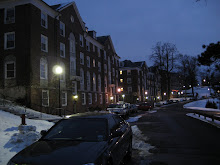 Here in Mexico I take a class at the University of Guanajuato called "Arte Mesoamericano" with a few other extranjeros from the US and Europe and three Mexicans. The class is held at a Mexican university where the vast majority of students are Mexican, but the professor speaks relatively slowly and he's not too tough, so a disproportionate number of non-Mexicans sign up every semester. Once a week we all sit in an auditorium for four hours staring at slides of rock piles put together by ancient civilizations. It's generally pretty boring, especially as the last of four classes I sit through every Wednesday. Thankfully, there's a catch: everyone in the class gets to go on a 10-day trip to the Yucatan to climb all over the stuff they've been learning about all semester, which to me makes the class more than worth taking.
Here in Mexico I take a class at the University of Guanajuato called "Arte Mesoamericano" with a few other extranjeros from the US and Europe and three Mexicans. The class is held at a Mexican university where the vast majority of students are Mexican, but the professor speaks relatively slowly and he's not too tough, so a disproportionate number of non-Mexicans sign up every semester. Once a week we all sit in an auditorium for four hours staring at slides of rock piles put together by ancient civilizations. It's generally pretty boring, especially as the last of four classes I sit through every Wednesday. Thankfully, there's a catch: everyone in the class gets to go on a 10-day trip to the Yucatan to climb all over the stuff they've been learning about all semester, which to me makes the class more than worth taking.Just yesterday I got back from said 10-day trip, sunburned and tired, but infinitely grateful for the chance I was given to see some of the most incredible structures human beings have ever built. If anyone reading this has ever thought about visiting places like Chichen Itza, Ek Balam, Uxmal, Tulum, or Coba, please go, you will not regret it. Shit, if you're thinking about spending spring break in Cancun or Playa del Carmen, take a few days away from the beach and the white folk to see these places. I was consistenly floored by the scale and beauty of each site, and I want to go back as soon as I can. Each structure is unique, and the jungle surroundings of the whole region are truly spectacular.
My class was fortunate enough to make the trip with our professor, who is an expert on pretty much everything Mesoamerica. When we weren't gawking upward at massive pyramids and temples, we got to walk along several "sacbes," which are elevated stone roads linking one ancient city to the next.
 Some of these roads stretch hundreds of miles, linking four of five cities and extremely diverse cultures. The sacbes served as trade routes, and they were marked by intricately-decorated archways at the boundary of each new civilization (see photo at right).
Some of these roads stretch hundreds of miles, linking four of five cities and extremely diverse cultures. The sacbes served as trade routes, and they were marked by intricately-decorated archways at the boundary of each new civilization (see photo at right).The Mayans were smart in a lot of ways, and they understood something very important: the more expensive trade becomes, the less likely it is to take place. The cheaper trade becomes, the more it will happen. Therefore, the Mayans sought to eliminate as many barriers to trade as possible. They created sturdy, well-kept roads, making things like thick jungles and tall grass less of a problem. Trade costs went down, and the trafficking of corn, water, stones, or whatever became easier. People prospered as a result.
More trade is good. Trade barriers are bad.
But hell, don't take my word for it. Read this, or this, or this, or this.
Just finished Youtubing the democratic debate I missed last week... forgive me if I'm a little frustrated.

No comments:
Post a Comment